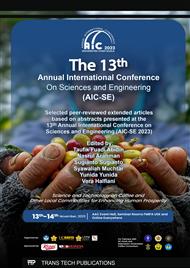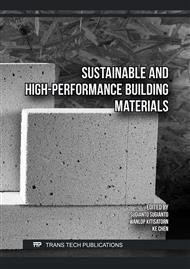[1]
N. Tripathi, M. Misra, and A. K. Mohanty, "Durable polylactic acid (PLA)-based sustainable engineered blends and bio composites: Recent developments, challenges, and opportunities," ACS Eng. Au, vol. 1, no. 1, p.7–38, 2021.
DOI: 10.1021/acsengineeringau.1c00011
Google Scholar
[2]
M. R. M. Asyraf et al., "Mechanical properties of oil palm fibre-reinforced polymer composites: A review," J. Mater. Res. Technol., vol. 17, p.33–65, 2022.
Google Scholar
[3]
F. J. Liando, S. O. Dapas, and S. E. Wallah, "PPlanning of reinforced concrete structure of 5-storey lecture building," J. Sipil Statik, vol. 8, no. 4, 2020.
Google Scholar
[4]
T.H. Bagio, E.Y. Baggio, S.W. Mudjanarko, and P.R.T. Naibaho, "Reinforced Concrete Beam and Column Programming Based on SNI: 2847-2019 On Smartphone Using Texas Instruments," ASTONJADRO, vol. 10, no. 2, p.287–300, 2021.
DOI: 10.32832/astonjadro.v10i2.5101
Google Scholar
[5]
S. Pranav, S. Aggarwal, E.-H. Yang, A. K. Sarkar, A. P. Singh, and M. Lahoti, "Alternative materials for wearing course of concrete pavements: A critical review," Constr. Build. Mater., vol. 236, p.117609, 2020.
DOI: 10.1016/j.conbuildmat.2019.117609
Google Scholar
[6]
A. V. R. Sihombing, B. S. Subagio, E. S. Hariyadi, A. M. Mulyadi, R. Utami, and R. P. Sihombing, "Effect of bio rejuvenator types on microstructure, mechanistic performance, and resilient modulus prediction model of asphalt concrete containing recycled materials in Indonesia," J. King Saud Univ.-Eng. Sci., 2023.
DOI: 10.1016/j.jksues.2023.04.001
Google Scholar
[7]
A. Surahyo, Surahyo, and Luby, Concrete construction. Springer, 2019.
Google Scholar
[8]
M. D. Fauzan, "THE USAGE OF RATTAN FIBER TO IMPROVE THE CONCRETE QUALITY," 2019.
Google Scholar
[9]
A. S. Dastgerdi, R. J. Peterman, K. Riding, and B. T. Beck, "Effect of concrete mixture components, proportioning, and compressive strength on fracture parameters," Constr. Build. Mater., vol. 206, p.179–192, 2019.
DOI: 10.1016/j.conbuildmat.2019.02.025
Google Scholar
[10]
M. D. Rout, S. Biswas, K. Shubham, and A. K. Sinha, "A systematic review on performance of reclaimed asphalt pavement (RAP) as sustainable material in rigid pavement construction: Current status to future perspective," J. Build. Eng., vol. 76, p.107253, 2023.
DOI: 10.1016/j.jobe.2023.107253
Google Scholar
[11]
Z. Jiang, C. Tang, J. Yang, Y. You, and Z. Lv, "A lab study to develop polyurethane concrete for bridge deck pavement," Int. J. Pavement Eng., vol. 23, no. 5, p.1404–1412, 2022.
DOI: 10.1080/10298436.2020.1804063
Google Scholar
[12]
S. Deb, N. Mitra, S. B. Majumder, and S. Maitra, "Improvement in tensile and flexural ductility with the addition of different types of polypropylene fibers in cementitious composites," Constr. Build. Mater., vol. 180, p.405–411, 2018.
DOI: 10.1016/j.conbuildmat.2018.05.280
Google Scholar
[13]
H. Gholizadeh and S. Dilmaghani, "The study of mechanical properties of high strength concrete containing steel and polypropylene fibers," Civ. Eng. J., vol. 4, no. 1, p.221–230, 2018.
DOI: 10.28991/cej-030981
Google Scholar
[14]
A. Rai and Y. P. Joshi, "Applications and properties of fibre reinforced concrete," J. Eng. Res. Appl., vol. 4, no. 5, p.123–131, 2014.
Google Scholar
[15]
Z. H. Mohebi, A. B. Bahnamiri, and M. Dehestani, "Effect of polypropylene fibers on bond performance of reinforcing bars in high strength concrete," Constr. Build. Mater., vol. 215, p.401–409, 2019.
DOI: 10.1016/j.conbuildmat.2019.04.230
Google Scholar
[16]
A.C. Bhogayata and N. K. Arora, "Fresh and strength properties of concrete reinforced with metalized plastic waste fibers," Constr. Build. Mater., vol. 146, p.455–463, 2017.
DOI: 10.1016/j.conbuildmat.2017.04.095
Google Scholar
[17]
L. Lanzoni, A. Nobili, and A.M. Tarantino, "Performance evaluation of a polypropylene-based draw-wired fibre for concrete structures," Constr. Build. Mater., vol. 28, no. 1, p.798–806, 2012.
DOI: 10.1016/j.conbuildmat.2011.10.017
Google Scholar
[18]
Y. Wang, H. C. Wu, and V. C. Li, "Concrete reinforcement with recycled fibers," J. Mater. Civ. Eng., vol. 12, no. 4, p.314–319, 2000.
DOI: 10.1061/(asce)0899-1561(2000)12:4(314)
Google Scholar
[19]
F. S. Khalid, J. M. Irwan, M. W. Ibrahim, N. Othman, and S. Shahidan, "Performance of plastic wastes in fiber-reinforced concrete beams," Constr. Build. Mater., vol. 183, p.451–464, 2018.
DOI: 10.1016/j.conbuildmat.2018.06.122
Google Scholar
[20]
C. Signorini and V. Volpini, "Mechanical performance of fiber reinforced cement composites including fully-recycled plastic fibers," Fibers, vol. 9, no. 3, p.16, 2021.
DOI: 10.3390/fib9030016
Google Scholar
[21]
R. F. Zollo, "Fiber-reinforced concrete: an overview after 30 years of development," Cem. Concr. Compos., vol. 19, no. 2, p.107–122, 1997.
DOI: 10.1016/s0958-9465(96)00046-7
Google Scholar
[22]
I. Shah, J. Li, S. Yang, Y. Zhang, and A. Anwar, "Experimental investigation on the mechanical properties of natural fiber reinforced concrete," J. Renew. Mater., vol. 10, no. 5, p.1307, 2022.
DOI: 10.32604/jrm.2022.017513
Google Scholar
[23]
A. Geremew, P. De Winne, T. A. Demissie, and H. De Backer, "Treatment of natural fiber for application in concrete pavement," Adv. Civ. Eng., vol. 2021, p.1–13, 2021.
DOI: 10.1155/2021/6667965
Google Scholar
[24]
I. S. Kishore and C. M. Chowdary, "Influence of Steel Fibers as Admix in Normal Concrete Mix," Int. J. Civ. Eng. Technol., vol. 7, no. 1, 2016.
Google Scholar
[25]
H. Wu et al., "A review of recent developments in application of plant fibers as reinforcements in concrete," J. Clean. Prod., p.138265, 2023.
Google Scholar
[26]
R. Merli, M. Preziosi, A. Acampora, M. C. Lucchetti, and E. Petrucci, "Recycled fibers in reinforced concrete: A systematic literature review," J. Clean. Prod., vol. 248, p.119207, 2020.
DOI: 10.1016/j.jclepro.2019.119207
Google Scholar
[27]
H. Abdollahiparsa, A. Shahmirzaloo, P. Teuffel, and R. Blok, "A review of recent developments in structural applications of natural fiber-Reinforced composites (NFRCs)," Compos. Adv. Mater., vol. 32, p.26349833221147540, 2023.
DOI: 10.1177/26349833221147540
Google Scholar
[28]
A. M. Febriana, S. Nisumanti, and U. S. Minaka, "The Effect of Adding Coconut Fiber Ash and Sikacim Concrete Additive on the Compressive Strength of Concrete," J. Gradasi Tek. Sipil, vol. 6, no. 2, p.74–81, 2022.
DOI: 10.31961/gradasi.v6i2.1470
Google Scholar
[29]
A. Yusra, I. Y. Salena, D. P. Sari, and A. Asrianur, "The Influence of Rattan Fibre Addition to The Compressive Strength of Normal Concrete," in IOP Conference Series: Earth and Environmental Science, IOP Publishing, 2021, p.012019.
DOI: 10.1088/1755-1315/832/1/012019
Google Scholar
[30]
A. Yusra, H. Meliana2b, L. Opirina, and A. Satria, "Investigation of normal concrete properties with the addition of micro reinforcement," 2023.
Google Scholar
[31]
X. Zhou, H. Saini, and G. Kastiukas, "Engineering properties of treated natural hemp fiber-reinforced concrete," Front. Built Environ., vol. 3, p.33, 2017.
DOI: 10.3389/fbuil.2017.00033
Google Scholar
[32]
G. Gedik and O. Avinc, "Hemp fiber as a sustainable raw material source for textile industry: can we use its potential for more eco-friendly production?," Sustain. Text. Appar. Ind. Sourc. Nat. Raw Mater., p.87–109, 2020.
DOI: 10.1007/978-3-030-38541-5_4
Google Scholar
[33]
R. B. Malabadi, K. P. Kolkar, and R. K. Chalannavar, "Industrial Cannabis sativa (Hemp fiber): Hempcrete-A Plant Based and Eco-friendly Building Construction Material".
Google Scholar
[34]
M. D. W. Rahman and Y. Risdianto, "Utilization of Jute Sack Fiber (Hemp) as a Concrete Additive and Electric Arc Furnace Slag 30% as a Sand Substituent in Normal Concrete Making," Rekayasa Tek. Sipil, vol. 2, no. 1, p.1–7, 2019.
Google Scholar
[35]
I. Wikana and T. Haryanto, "Efforts to Increase the Bending Strength of Concrete Blocks with Hemp Rope," Dalam Maj. Ilm. UKRIM Ed., vol. 1, 2007.
Google Scholar
[36]
S. Ahmad and K. S. Akhtar, "Textile Raw Materials," Pak. High. Educ. Comm., p.190, 2017.
Google Scholar
[37]
B. A. Tamoro, "Karakteristik Beton Substitusi Fly Ash Dengan Penambahan Serat Rami," Universitas Gadjah Mada, 2016.
Google Scholar
[38]
J. P. Manaia, A. T. Manaia, and L. Rodriges, "Industrial hemp fibers: An overview," Fibers, vol. 7, no. 12, p.106, 2019.
DOI: 10.3390/fib7120106
Google Scholar
[39]
E. Awwad, M. Mabsout, B. Hamad, M. T. Farran, and H. Khatib, "Studies on fiber-reinforced concrete using industrial hemp fibers," Constr. Build. Mater., vol. 35, p.710–717, 2012.
DOI: 10.1016/j.conbuildmat.2012.04.119
Google Scholar
[40]
E.G. Nawy, A. Moreton, B. Mather, M. Malhotra, and M. Sprinkel, "Concrete Properties," Transp. New Millenn., 2000.
Google Scholar
[41]
A. CODE, "318-14: Building Code Requirements for Structural Concrete and Commentary," Am. Concr. Inst. Farmington Hills MI USA, 2014.
Google Scholar
[42]
A. R. Villca et al., "Lime/pozzolan/geopolymer systems: Performance in pastes and mortars," Constr. Build. Mater., vol. 276, p.122208, 2021.
DOI: 10.1016/j.conbuildmat.2020.122208
Google Scholar
[43]
A. Pambudi, M. Farid, and J. A. R. Hakim, "Morphological Analysis and Infrared Spectroscopy of Betung Bamboo Fiber (Dendrocalamus Asper) Results of the Alkalization Process as a Composite Booster for Sound Absorption," vol. 6, no. 2, 2017.
Google Scholar
[44]
M. Helinski, A. Fourie, M. Fahey, and M. Ismail, "Assessment of the self-desiccation process in cemented mine backfills," Can. Geotech. J., vol. 44, no. 10, p.1148–1156, 2007.
DOI: 10.1139/t07-051
Google Scholar
[45]
A. ACI, Building code requirements for structural concrete and commentary. 2014.
Google Scholar
[46]
O. Gencel et al., "Characteristics of hemp fibre reinforced foam concretes with fly ash and Taguchi optimization," Constr. Build. Mater., vol. 294, p.123607, 2021.
DOI: 10.1016/j.conbuildmat.2021.123607
Google Scholar
[47]
A.I.C.C. on C. and C. Aggregates, Standard test method for compressive strength of cylindrical concrete specimens. ASTM international, 2014.
Google Scholar
[48]
A.C. Committee, "State of the Art Report in Fiber Reinforced Concrete," ACI Am. Concr. Inst. Farmington Hills MI USA, 1982.
Google Scholar
[49]
M. Brindha, S. Khan, S.S. Narayanan, A.S. Kumar, and V. Viviek, "Properties of concrete reinforced with bamboo fibre," Int J Innov Res Sci Eng Technol, vol. 6, no. 3, p.3809–3812, 2017.
Google Scholar
[50]
S. Liu, D. Gao, and B. Chen, "Experimental investigation on Steel-Bamboo Composite shear connections," J. Build. Eng., vol. 61, p.105207, 2022.
DOI: 10.1016/j.jobe.2022.105207
Google Scholar



